Human Development in Adolescence
VerifiedAdded on 2023/04/19
|8
|2188
|158
AI Summary
This essay provides an overview of the developmental period of adolescence and the milestones that are experienced at this time. The essay also analyses the adolescent stage in relation to two theories of the developmental psychology. The essay also includes a reflection on the personal experiences in relation to this significant stage of life.
Contribute Materials
Your contribution can guide someone’s learning journey. Share your
documents today.
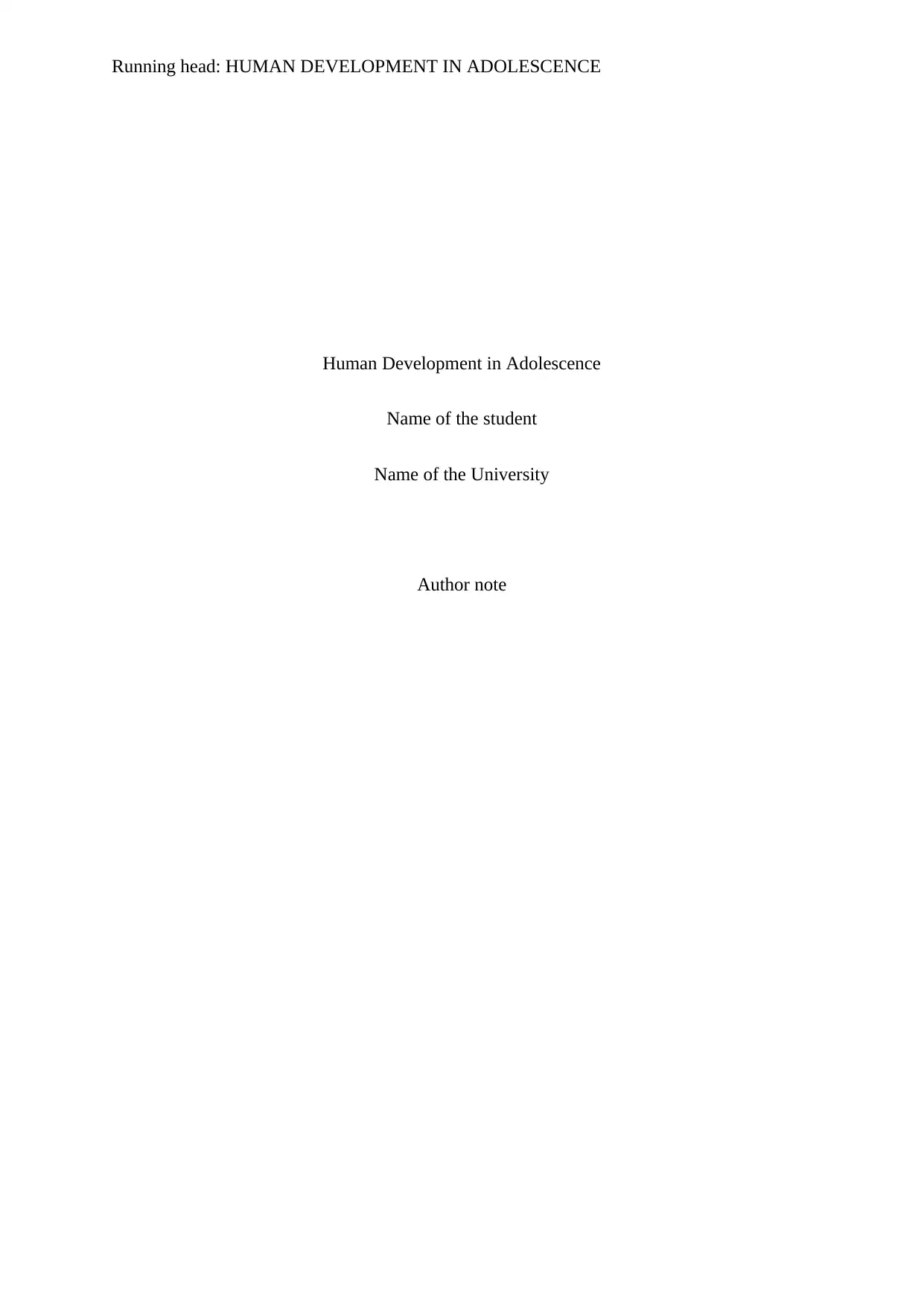
Running head: HUMAN DEVELOPMENT IN ADOLESCENCE
Human Development in Adolescence
Name of the student
Name of the University
Author note
Human Development in Adolescence
Name of the student
Name of the University
Author note
Secure Best Marks with AI Grader
Need help grading? Try our AI Grader for instant feedback on your assignments.

1HUMAN DEVELOPMENT IN ADOLESCENCE
Human Development is indicative of biological along with the psychological
development of an individual across lifespan. It is indicative of the development that takes
place from the infancy stage to the adulthood stage. Adolescence refers to transitional stage
pertaining to physical along with the psychological development that takes place from the
period of puberty to that of legal adulthood (Ahmed, Bittencourt-Hewitt & Sebastian, 2015).
Adolescence can be said to be related to teenage years however physical and the
psychological expressions can begin in the earlier stage and end in the later stage. This essay
provides an overview of the developmental period of adolescence and the milestones that are
experienced at this time. The essay also analyses the adolescent stage in relation to two
theories of the developmental psychology. The essay also includes a reflection on the
personal experiences in relation to this significant stage of life.
Adolescence refers to transitional phase of the growth in between the childhood and
the adulthood. World Health Organization has defined adolescent as a person who is between
the age of 10 and that of 24. There are various societies in the world that have equated
adolescence with the stage of puberty. There are various kinds of physical changes that takes
place in adolescent stage which culminates in the reproductive maturity of an individual.
There are many societies where the adolescence can be understood in the broader terms that
helps in encompassing the psychological and the social terrain along with the physical
aspects of the maturation (Boyd, Bee & Johnson, 2015). At the stage of adolescence, the
boys and the girls become emotionally distanced from their parents. This separation can help
in establishing the personal values of an individual and it helps an individual in becoming
self-sufficient. According to Crone and Konijn (2018), the teenagers do not have clear roles
in the society but they occupy the ambiguous period in between the childhood and the
adulthood. An individual undergoes upsurge of the sexual feelings in the adolescent stage that
follows latent sexuality of the childhood years. The adolescents are portrayed as being
Human Development is indicative of biological along with the psychological
development of an individual across lifespan. It is indicative of the development that takes
place from the infancy stage to the adulthood stage. Adolescence refers to transitional stage
pertaining to physical along with the psychological development that takes place from the
period of puberty to that of legal adulthood (Ahmed, Bittencourt-Hewitt & Sebastian, 2015).
Adolescence can be said to be related to teenage years however physical and the
psychological expressions can begin in the earlier stage and end in the later stage. This essay
provides an overview of the developmental period of adolescence and the milestones that are
experienced at this time. The essay also analyses the adolescent stage in relation to two
theories of the developmental psychology. The essay also includes a reflection on the
personal experiences in relation to this significant stage of life.
Adolescence refers to transitional phase of the growth in between the childhood and
the adulthood. World Health Organization has defined adolescent as a person who is between
the age of 10 and that of 24. There are various societies in the world that have equated
adolescence with the stage of puberty. There are various kinds of physical changes that takes
place in adolescent stage which culminates in the reproductive maturity of an individual.
There are many societies where the adolescence can be understood in the broader terms that
helps in encompassing the psychological and the social terrain along with the physical
aspects of the maturation (Boyd, Bee & Johnson, 2015). At the stage of adolescence, the
boys and the girls become emotionally distanced from their parents. This separation can help
in establishing the personal values of an individual and it helps an individual in becoming
self-sufficient. According to Crone and Konijn (2018), the teenagers do not have clear roles
in the society but they occupy the ambiguous period in between the childhood and the
adulthood. An individual undergoes upsurge of the sexual feelings in the adolescent stage that
follows latent sexuality of the childhood years. The adolescents are portrayed as being

2HUMAN DEVELOPMENT IN ADOLESCENCE
rebellious and distracted. The young people experiences physical and the social changes that
has an impact on their behaviour. At the time of puberty, the young bodies become infused
with the hormones that paves the path for the stimulation of their desire.
The main event at the stage of adolescence is that there is spurt in the growth that is
followed by the puberty changes. An adolescent grows several inches within many months
that is followed by a stage of slow growth. The event that takes place in adolescence is
physical maturation that takes place on account of the hormonal changes. It has been argued
by Allemand, Steiger and Fend (2015) that the pubertal change that takes place is the
enlarging of the testicles and the appearance of the public hair. The hair grows under arms
and on face at the adolescent stage and there is voice change that takes place in the adolescent
stage. The girls also face puberty however the pubertal change of the girls begins before boys
of same age (Steinsbekk & Wichstrøm, 2018). The pubertal change that takes place in the
girls leads to their breast development. The development of the public hair takes place after
the process of development of breast.
The theory of the Identity Development of Erik Erikson talks about the acquiring of
the ego-identity along with the identity characteristics that are crucial in relation to the
adolescence stage. The identity of a person can be established in various ways and it is
dependent on the culture of an individual. According to Ciarrochi et al. (2016), the
developing of a string ego-identity can take place with the help of meaningful recognition of
the achievements along with the accomplishments of a person. Erikson states that in the stage
of adolescence, an individual establishes sense of the personal identity. It helps in avoiding
dangers in relation to role diffusion along with the identity confusion. It has been argued by
Blakemore (2017) that an adolescent has to answer the questions for their own selves
regarding from where they are coming from. Identity is not provided to an individual by the
society but it should be acquired with the help of sustained individual efforts. Erikson talks
rebellious and distracted. The young people experiences physical and the social changes that
has an impact on their behaviour. At the time of puberty, the young bodies become infused
with the hormones that paves the path for the stimulation of their desire.
The main event at the stage of adolescence is that there is spurt in the growth that is
followed by the puberty changes. An adolescent grows several inches within many months
that is followed by a stage of slow growth. The event that takes place in adolescence is
physical maturation that takes place on account of the hormonal changes. It has been argued
by Allemand, Steiger and Fend (2015) that the pubertal change that takes place is the
enlarging of the testicles and the appearance of the public hair. The hair grows under arms
and on face at the adolescent stage and there is voice change that takes place in the adolescent
stage. The girls also face puberty however the pubertal change of the girls begins before boys
of same age (Steinsbekk & Wichstrøm, 2018). The pubertal change that takes place in the
girls leads to their breast development. The development of the public hair takes place after
the process of development of breast.
The theory of the Identity Development of Erik Erikson talks about the acquiring of
the ego-identity along with the identity characteristics that are crucial in relation to the
adolescence stage. The identity of a person can be established in various ways and it is
dependent on the culture of an individual. According to Ciarrochi et al. (2016), the
developing of a string ego-identity can take place with the help of meaningful recognition of
the achievements along with the accomplishments of a person. Erikson states that in the stage
of adolescence, an individual establishes sense of the personal identity. It helps in avoiding
dangers in relation to role diffusion along with the identity confusion. It has been argued by
Blakemore (2017) that an adolescent has to answer the questions for their own selves
regarding from where they are coming from. Identity is not provided to an individual by the
society but it should be acquired with the help of sustained individual efforts. Erikson talks

3HUMAN DEVELOPMENT IN ADOLESCENCE
about the fact that in the age of social change, older generation cannot act as the role model
for that of the younger generation. Older generation can provide the role models but the
adolescents reject them as being inappropriate in relation to their situation. Sigmund Freud
was of the opinion that adolescence referred to universal phenomenon that helped in
including the behavioural, social along with the emotional changes. The psychoanalytic
theory of Sigmund Freud lays focus on the early experiences that can help in shaping the
personality of an individual. According to Stafford et al. (2016), the kind of relationship that
is cultivated by the child and the level of the adjustment are influenced by quality of the
experiences that the children has in the psychosexual stage. Freud believed in the fact that
this stage is the latent period when the children lay focus on the other activities like the
schools, friends and the hobbies. Freud was of the opinion that the stage of adolescence helps
people in the development of social skills along with the self-confidence (Perret-Catipovic &
Ladame, 2018).
According to Erikson, the adolescents are preoccupied regarding what the other
people thinks about them and how they look in front of the eye of the other people. The youth
faces “physiological revolution” at the stage of adolescence which threatens the body image
of an individual. It interferes with that of formation of identity of an individual. The
adolescent feels the need of settling question of the vocational identity. It has been stated by
Kerpelman and Pittman (2018),that the adolescents have idealized conception in relation to
their vocational goal and it helps an individual in having a distinct position in the society. The
youth does not identify with the parents at the stage of adolescence and they have the
tendency of rebelling against the dominance of the parents (Fuhrmann, Knoll & Blakemore,
2015). The youth in the adolescent stage believes in the fact that they can establish their own
identity with the help of their actions. According to Freud, the oral stimulation can pave the
path for oral fixation in the later stage of life of the children. It has been found that the oral
about the fact that in the age of social change, older generation cannot act as the role model
for that of the younger generation. Older generation can provide the role models but the
adolescents reject them as being inappropriate in relation to their situation. Sigmund Freud
was of the opinion that adolescence referred to universal phenomenon that helped in
including the behavioural, social along with the emotional changes. The psychoanalytic
theory of Sigmund Freud lays focus on the early experiences that can help in shaping the
personality of an individual. According to Stafford et al. (2016), the kind of relationship that
is cultivated by the child and the level of the adjustment are influenced by quality of the
experiences that the children has in the psychosexual stage. Freud believed in the fact that
this stage is the latent period when the children lay focus on the other activities like the
schools, friends and the hobbies. Freud was of the opinion that the stage of adolescence helps
people in the development of social skills along with the self-confidence (Perret-Catipovic &
Ladame, 2018).
According to Erikson, the adolescents are preoccupied regarding what the other
people thinks about them and how they look in front of the eye of the other people. The youth
faces “physiological revolution” at the stage of adolescence which threatens the body image
of an individual. It interferes with that of formation of identity of an individual. The
adolescent feels the need of settling question of the vocational identity. It has been stated by
Kerpelman and Pittman (2018),that the adolescents have idealized conception in relation to
their vocational goal and it helps an individual in having a distinct position in the society. The
youth does not identify with the parents at the stage of adolescence and they have the
tendency of rebelling against the dominance of the parents (Fuhrmann, Knoll & Blakemore,
2015). The youth in the adolescent stage believes in the fact that they can establish their own
identity with the help of their actions. According to Freud, the oral stimulation can pave the
path for oral fixation in the later stage of life of the children. It has been found that the oral
Secure Best Marks with AI Grader
Need help grading? Try our AI Grader for instant feedback on your assignments.
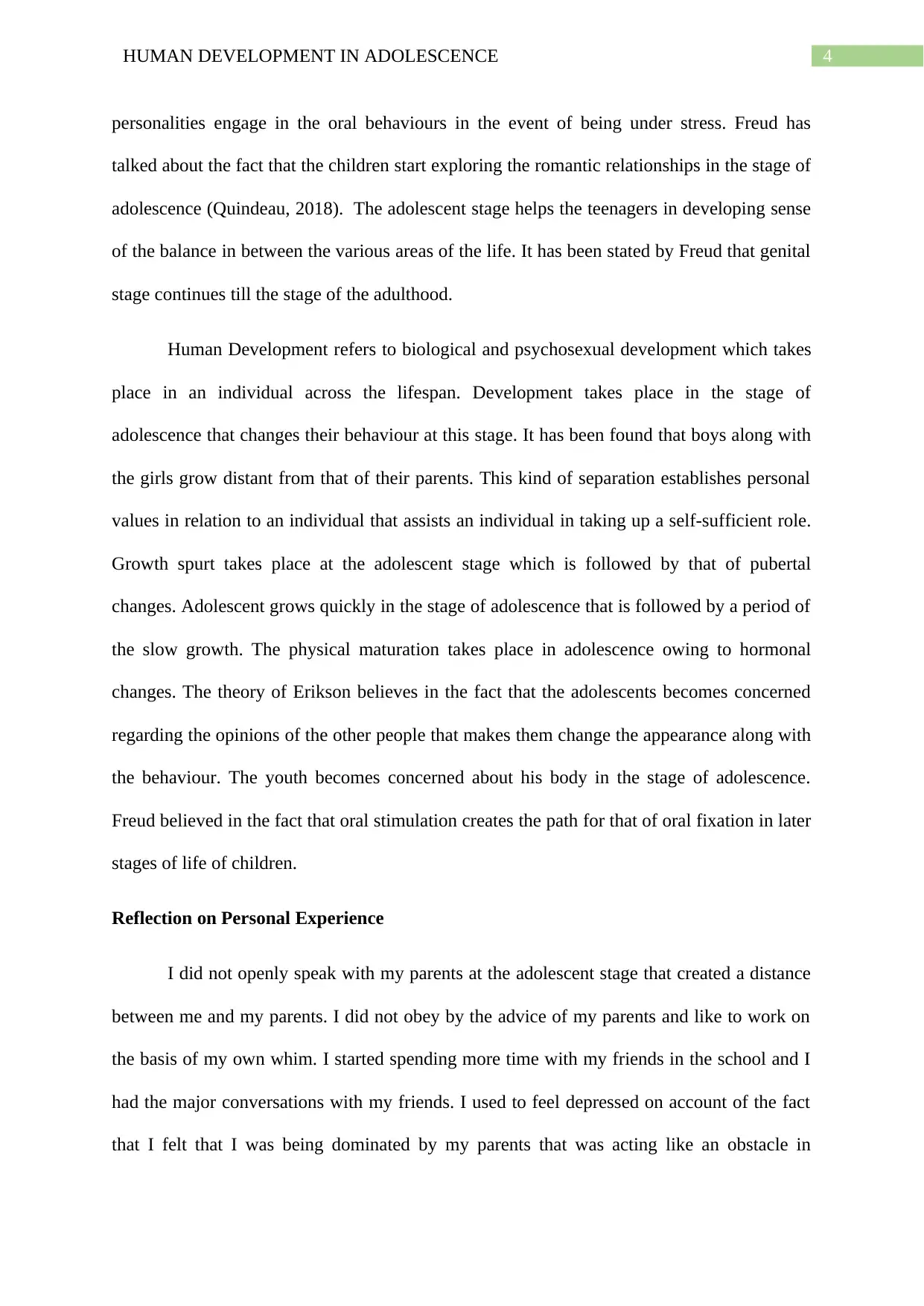
4HUMAN DEVELOPMENT IN ADOLESCENCE
personalities engage in the oral behaviours in the event of being under stress. Freud has
talked about the fact that the children start exploring the romantic relationships in the stage of
adolescence (Quindeau, 2018). The adolescent stage helps the teenagers in developing sense
of the balance in between the various areas of the life. It has been stated by Freud that genital
stage continues till the stage of the adulthood.
Human Development refers to biological and psychosexual development which takes
place in an individual across the lifespan. Development takes place in the stage of
adolescence that changes their behaviour at this stage. It has been found that boys along with
the girls grow distant from that of their parents. This kind of separation establishes personal
values in relation to an individual that assists an individual in taking up a self-sufficient role.
Growth spurt takes place at the adolescent stage which is followed by that of pubertal
changes. Adolescent grows quickly in the stage of adolescence that is followed by a period of
the slow growth. The physical maturation takes place in adolescence owing to hormonal
changes. The theory of Erikson believes in the fact that the adolescents becomes concerned
regarding the opinions of the other people that makes them change the appearance along with
the behaviour. The youth becomes concerned about his body in the stage of adolescence.
Freud believed in the fact that oral stimulation creates the path for that of oral fixation in later
stages of life of children.
Reflection on Personal Experience
I did not openly speak with my parents at the adolescent stage that created a distance
between me and my parents. I did not obey by the advice of my parents and like to work on
the basis of my own whim. I started spending more time with my friends in the school and I
had the major conversations with my friends. I used to feel depressed on account of the fact
that I felt that I was being dominated by my parents that was acting like an obstacle in
personalities engage in the oral behaviours in the event of being under stress. Freud has
talked about the fact that the children start exploring the romantic relationships in the stage of
adolescence (Quindeau, 2018). The adolescent stage helps the teenagers in developing sense
of the balance in between the various areas of the life. It has been stated by Freud that genital
stage continues till the stage of the adulthood.
Human Development refers to biological and psychosexual development which takes
place in an individual across the lifespan. Development takes place in the stage of
adolescence that changes their behaviour at this stage. It has been found that boys along with
the girls grow distant from that of their parents. This kind of separation establishes personal
values in relation to an individual that assists an individual in taking up a self-sufficient role.
Growth spurt takes place at the adolescent stage which is followed by that of pubertal
changes. Adolescent grows quickly in the stage of adolescence that is followed by a period of
the slow growth. The physical maturation takes place in adolescence owing to hormonal
changes. The theory of Erikson believes in the fact that the adolescents becomes concerned
regarding the opinions of the other people that makes them change the appearance along with
the behaviour. The youth becomes concerned about his body in the stage of adolescence.
Freud believed in the fact that oral stimulation creates the path for that of oral fixation in later
stages of life of children.
Reflection on Personal Experience
I did not openly speak with my parents at the adolescent stage that created a distance
between me and my parents. I did not obey by the advice of my parents and like to work on
the basis of my own whim. I started spending more time with my friends in the school and I
had the major conversations with my friends. I used to feel depressed on account of the fact
that I felt that I was being dominated by my parents that was acting like an obstacle in
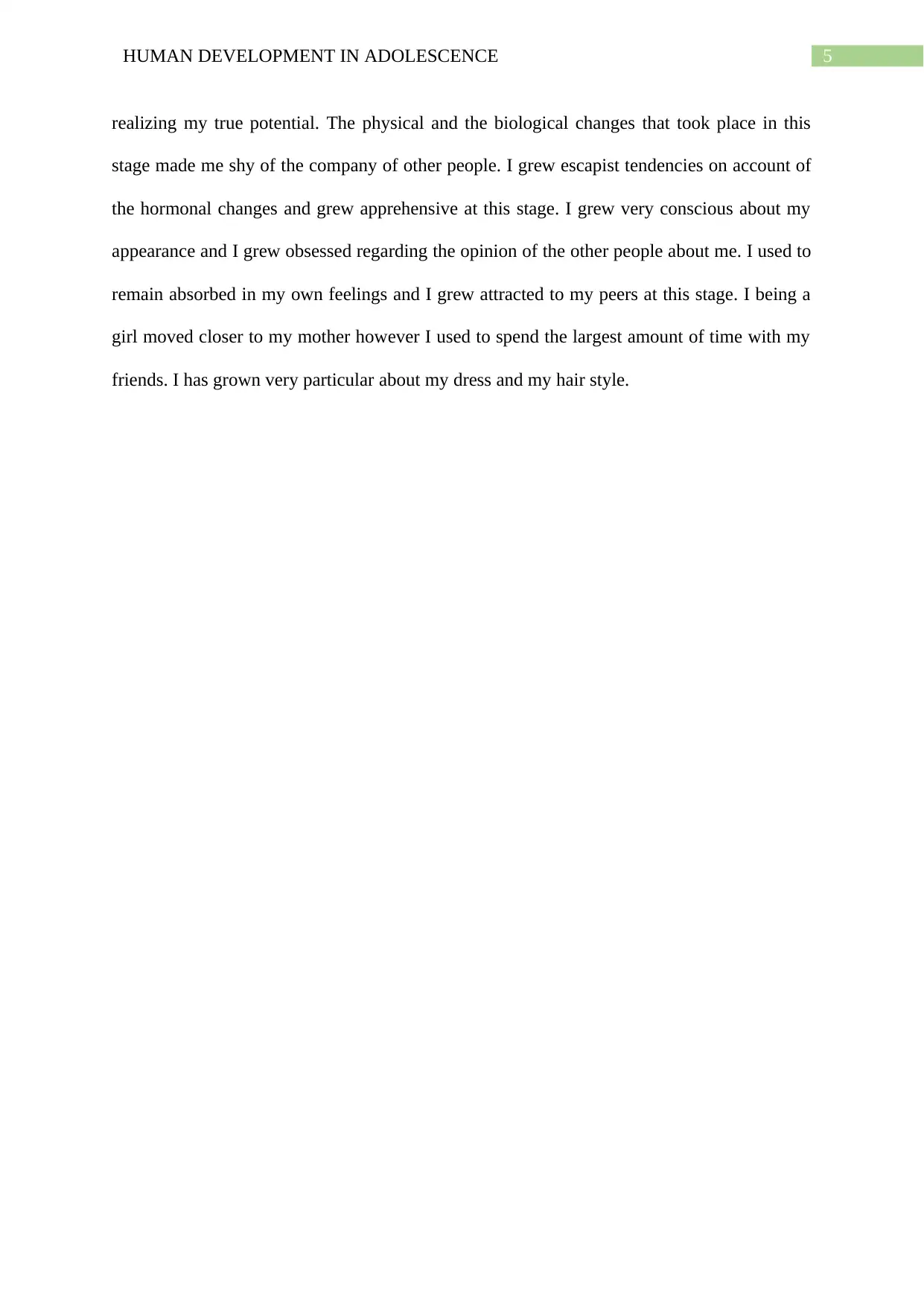
5HUMAN DEVELOPMENT IN ADOLESCENCE
realizing my true potential. The physical and the biological changes that took place in this
stage made me shy of the company of other people. I grew escapist tendencies on account of
the hormonal changes and grew apprehensive at this stage. I grew very conscious about my
appearance and I grew obsessed regarding the opinion of the other people about me. I used to
remain absorbed in my own feelings and I grew attracted to my peers at this stage. I being a
girl moved closer to my mother however I used to spend the largest amount of time with my
friends. I has grown very particular about my dress and my hair style.
realizing my true potential. The physical and the biological changes that took place in this
stage made me shy of the company of other people. I grew escapist tendencies on account of
the hormonal changes and grew apprehensive at this stage. I grew very conscious about my
appearance and I grew obsessed regarding the opinion of the other people about me. I used to
remain absorbed in my own feelings and I grew attracted to my peers at this stage. I being a
girl moved closer to my mother however I used to spend the largest amount of time with my
friends. I has grown very particular about my dress and my hair style.
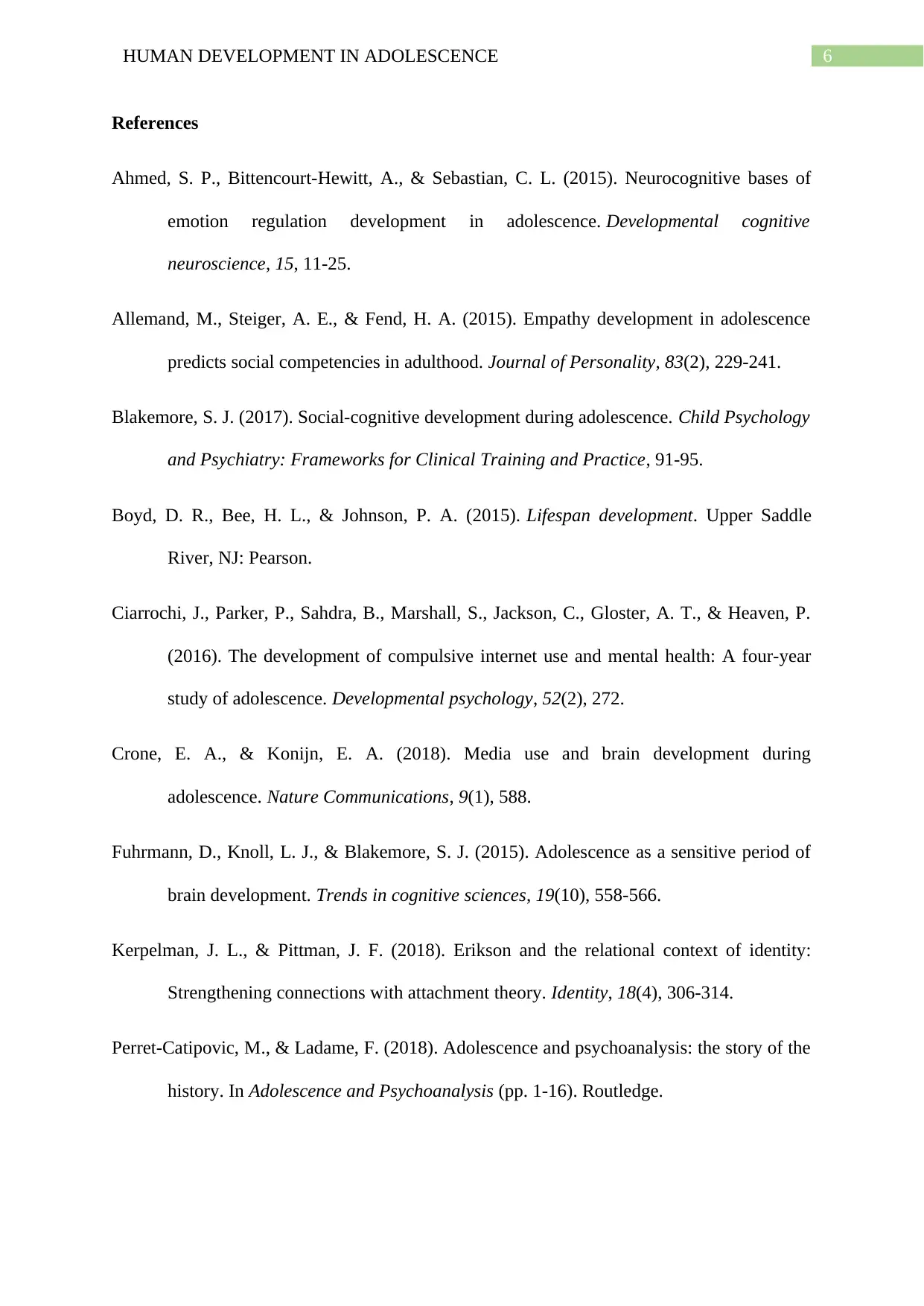
6HUMAN DEVELOPMENT IN ADOLESCENCE
References
Ahmed, S. P., Bittencourt-Hewitt, A., & Sebastian, C. L. (2015). Neurocognitive bases of
emotion regulation development in adolescence. Developmental cognitive
neuroscience, 15, 11-25.
Allemand, M., Steiger, A. E., & Fend, H. A. (2015). Empathy development in adolescence
predicts social competencies in adulthood. Journal of Personality, 83(2), 229-241.
Blakemore, S. J. (2017). Social‐cognitive development during adolescence. Child Psychology
and Psychiatry: Frameworks for Clinical Training and Practice, 91-95.
Boyd, D. R., Bee, H. L., & Johnson, P. A. (2015). Lifespan development. Upper Saddle
River, NJ: Pearson.
Ciarrochi, J., Parker, P., Sahdra, B., Marshall, S., Jackson, C., Gloster, A. T., & Heaven, P.
(2016). The development of compulsive internet use and mental health: A four-year
study of adolescence. Developmental psychology, 52(2), 272.
Crone, E. A., & Konijn, E. A. (2018). Media use and brain development during
adolescence. Nature Communications, 9(1), 588.
Fuhrmann, D., Knoll, L. J., & Blakemore, S. J. (2015). Adolescence as a sensitive period of
brain development. Trends in cognitive sciences, 19(10), 558-566.
Kerpelman, J. L., & Pittman, J. F. (2018). Erikson and the relational context of identity:
Strengthening connections with attachment theory. Identity, 18(4), 306-314.
Perret-Catipovic, M., & Ladame, F. (2018). Adolescence and psychoanalysis: the story of the
history. In Adolescence and Psychoanalysis (pp. 1-16). Routledge.
References
Ahmed, S. P., Bittencourt-Hewitt, A., & Sebastian, C. L. (2015). Neurocognitive bases of
emotion regulation development in adolescence. Developmental cognitive
neuroscience, 15, 11-25.
Allemand, M., Steiger, A. E., & Fend, H. A. (2015). Empathy development in adolescence
predicts social competencies in adulthood. Journal of Personality, 83(2), 229-241.
Blakemore, S. J. (2017). Social‐cognitive development during adolescence. Child Psychology
and Psychiatry: Frameworks for Clinical Training and Practice, 91-95.
Boyd, D. R., Bee, H. L., & Johnson, P. A. (2015). Lifespan development. Upper Saddle
River, NJ: Pearson.
Ciarrochi, J., Parker, P., Sahdra, B., Marshall, S., Jackson, C., Gloster, A. T., & Heaven, P.
(2016). The development of compulsive internet use and mental health: A four-year
study of adolescence. Developmental psychology, 52(2), 272.
Crone, E. A., & Konijn, E. A. (2018). Media use and brain development during
adolescence. Nature Communications, 9(1), 588.
Fuhrmann, D., Knoll, L. J., & Blakemore, S. J. (2015). Adolescence as a sensitive period of
brain development. Trends in cognitive sciences, 19(10), 558-566.
Kerpelman, J. L., & Pittman, J. F. (2018). Erikson and the relational context of identity:
Strengthening connections with attachment theory. Identity, 18(4), 306-314.
Perret-Catipovic, M., & Ladame, F. (2018). Adolescence and psychoanalysis: the story of the
history. In Adolescence and Psychoanalysis (pp. 1-16). Routledge.
Paraphrase This Document
Need a fresh take? Get an instant paraphrase of this document with our AI Paraphraser
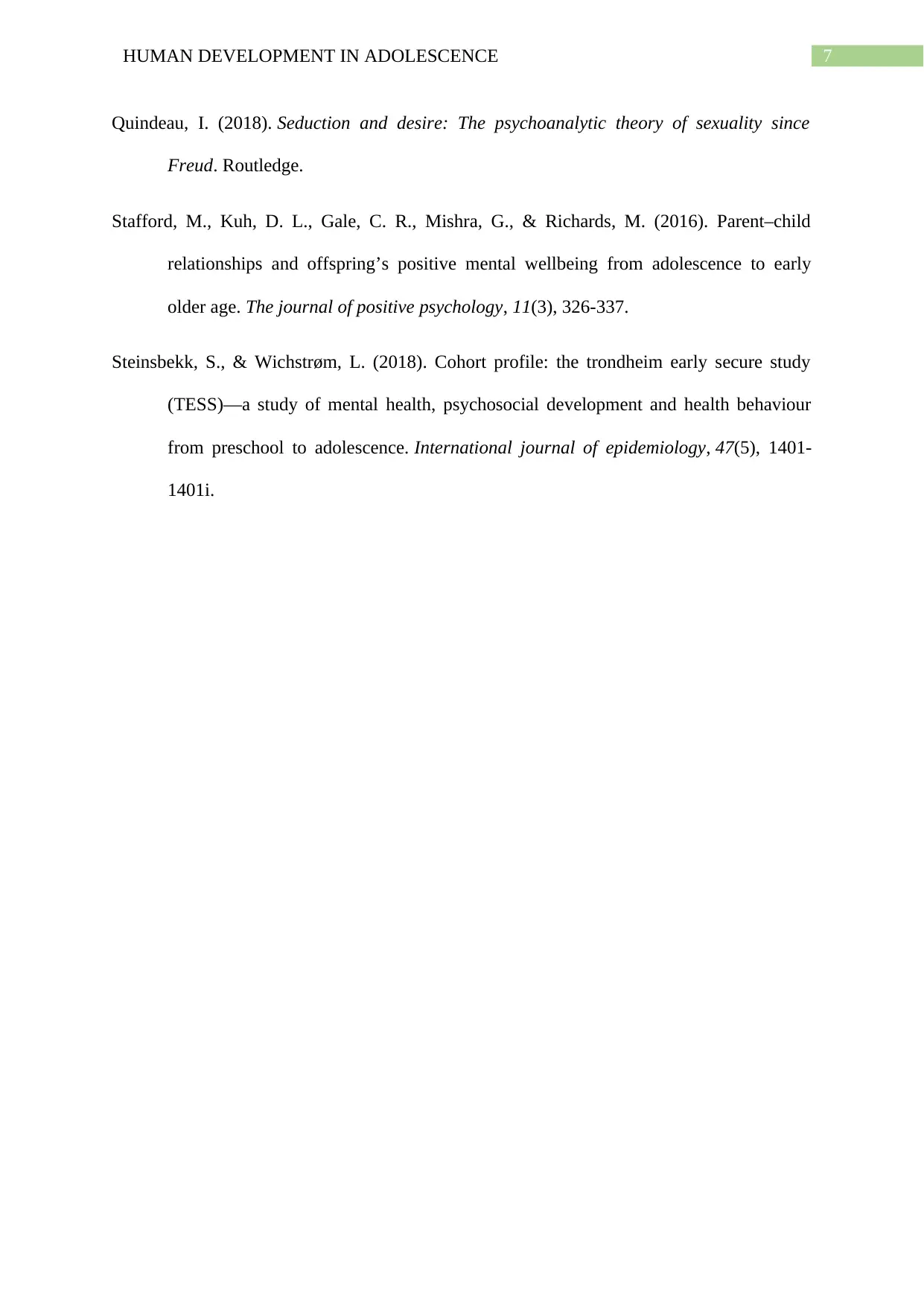
7HUMAN DEVELOPMENT IN ADOLESCENCE
Quindeau, I. (2018). Seduction and desire: The psychoanalytic theory of sexuality since
Freud. Routledge.
Stafford, M., Kuh, D. L., Gale, C. R., Mishra, G., & Richards, M. (2016). Parent–child
relationships and offspring’s positive mental wellbeing from adolescence to early
older age. The journal of positive psychology, 11(3), 326-337.
Steinsbekk, S., & Wichstrøm, L. (2018). Cohort profile: the trondheim early secure study
(TESS)—a study of mental health, psychosocial development and health behaviour
from preschool to adolescence. International journal of epidemiology, 47(5), 1401-
1401i.
Quindeau, I. (2018). Seduction and desire: The psychoanalytic theory of sexuality since
Freud. Routledge.
Stafford, M., Kuh, D. L., Gale, C. R., Mishra, G., & Richards, M. (2016). Parent–child
relationships and offspring’s positive mental wellbeing from adolescence to early
older age. The journal of positive psychology, 11(3), 326-337.
Steinsbekk, S., & Wichstrøm, L. (2018). Cohort profile: the trondheim early secure study
(TESS)—a study of mental health, psychosocial development and health behaviour
from preschool to adolescence. International journal of epidemiology, 47(5), 1401-
1401i.
1 out of 8
Related Documents
Your All-in-One AI-Powered Toolkit for Academic Success.
+13062052269
info@desklib.com
Available 24*7 on WhatsApp / Email
![[object Object]](/_next/static/media/star-bottom.7253800d.svg)
Unlock your academic potential
© 2024 | Zucol Services PVT LTD | All rights reserved.





